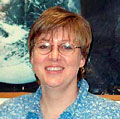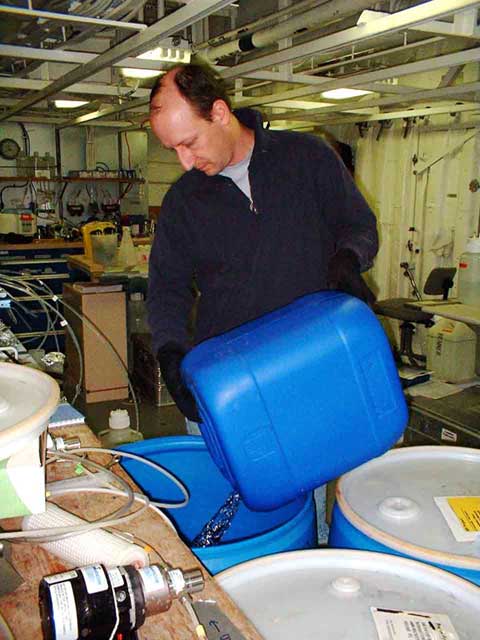 |
|
|
| Author |
Message |
Patty_Cie

Joined: 23 Mar 2004
Posts: 87

|
 Posted:
Wed Jun 02, 2004 6:43 pm Posted:
Wed Jun 02, 2004 6:43 pm |
  |
May 28, 2004 Friday
7:30 PM Alaska time
Chemicals found in seawater are used in many, varied experiments. David Kadko of the University of Miami uses radium isotope decay as a time tracer to study the movement of well-mixed arctic shelf water into the deep arctic basins. David was unable to be aboard the Healy this cruise, but, his associates Mark Stephens and Bob Wolfe are here collecting samples.
The element thorium sticks well to particles and is found in most sediment. As thorium decays, it becomes radium. While thorium sticks to particles, radium leaches into the water. In shallow areas like the arctic shelves, water is well mixed, meaning that water circulates from the surface to the seafloor. As a result, the water particles on the shelves are more likely to have contact with the benthic (bottom) sediment and absorb leaching radium. Therefore, radium found throughout shelf water is continuously being refreshed. However, in the deep, poorly mixed water, like that found in the arctic basins, not all the water particles contact the seafloor. Consequently the radium is not refreshed and begins to decay. Since the half-life of radium isotopes is a known time, it is possible to compare the radium isotopes found on the shelves to the radium isotopes found in the basins and determine how long it took for water to travel a given distance.
To collect radium isotopes from seawater, Mark and Bob fill 55 gallon barrels with surface and bottom water. They filter each barrel of water through a tube filled with manganese-coated acrylic fiber. As the water passes through the fiber, the manganese captures the radium. Next, they remove the fiber from the tubes. The fiber is sealed in a tube that is connected to a machine called a Radecc System. In the Radecc System, radium decays into radon gas. The black hollow chambers of the system are coated with a material that phosphoresces when radon decays. At the bottom of the system is a photomultiplier tube that detects flashes of light. As the radon decays it emits a photon causing a flash of light. A computer counts the light flashes. Then, using a mathematical formula, the amount of radium-224 isotope in the fiber is extrapolated from the flash count of the radon gas. The fiber is sealed in Petri dishes and taken back to Miami to measure the amount of radium isotopes 226 and 228.

Mark Stephens fills 55 gallons barrels with surface and bottom seawater.

Bob Wolfe removes manganese-coated acrylic fiber from a tube that has filtered 55 gallons of water.

A Radecc System is used to measure radon gas.
To see photographs taken by Steve Roberts of UCAR/JOSS, click here. |
|
|
    |
 |
|
|
|
View next topic
View previous topic
You cannot post new topics in this forum
You cannot reply to topics in this forum
You cannot edit your posts in this forum
You cannot delete your posts in this forum
You cannot vote in polls in this forum
You cannot attach files in this forum
You can download files in this forum
|
Powered by phpBB 2.0.11
© 2001, 2002 phpBB Group :: FI Theme ::
All times are GMT
| |
